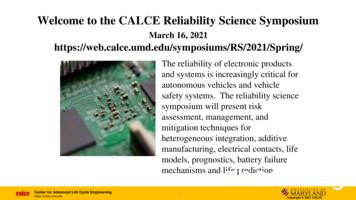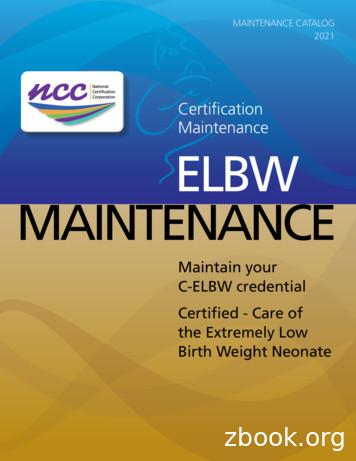Safety, Reliability, Certification, Maintenance
MITICATSafety, Reliability, Certification,MaintenanceProf. R. John HansmanMIT International Center for Air Transportation
MITICAT
MITICATU.S. Military Accident Rates#4.0Accident Rate3.0MarineCorps2.0NavyAir Force1.001992Army1994199619982000#Class A accidents per 100,000 flight hours.Figure by MIT OCW. Adapted from: AviationWeek 10/02.2002
MITICAT
MITICAT
MITICAT
MITICAT
MITICAT
MITICAT
MITICATSafetyy Safety Targets/Standards Civil Air Carrier Civil General Aviation MilitaryFAR Part 25FAR Part 23Mil Specy Safety ComponentsVehicle AirworthinessTraining and Operating ProceduresMaintenanceCulture Quality Management Processes Incident Reporting Accident Investigation Liability y Design Philosophy Fail Safe Fail OperationalFAR Part 121FAR Part 91
MITICATCertificationy Civil Certificate of Airworthiness (i.e. Certification) Guarantee to the public that the aircraft is airworthy to somestandard Operational Approval Operating CertificateÐEquipmentÐProceduresÐTrainingy Military Procurementy Space Man Rated
MITICATCertificationy Aircraft Certificate of Airworthiness Standard Type Certificate (STC) Categories Air Carrier Normal Utility Experimental Rotorcraft LTA Others
MITICATCertificationy Component Certificate of Airworthiness Engines Propellers Parts Instrumentsy Component (Parts & Instruments) Standards Technical Service Order (TSO) Minimum Operational Performance Specification (MOPS)y Software Standards RTCA DO-178By Continued Airworthiness Inspections Maintenance
MITICATFederal Aviation RegulationsyPart 1 - DEFINITIONS AND ABBREVIATIONSyPart 11 - GENERAL RULEMAKING PROCEDURESyPart 21 - CERTIFICATION PROCEDURES FOR PRODUCTS AND PARTSyPart 23 - AIRWORTHINESS STANDARDS: NORMAL, UTILITY, ACROBATIC, ANDCOMMUTER CATEGORY AIRPLANESyPart 25 - AIRWORTHINESS STANDARDS: TRANSPORT CATEGORY AIRPLANESyPart 27 - AIRWORTHINESS STANDARDS: NORMAL CATEGORY ROTORCRAFTyPart 29 - AIRWORTHINESS STANDARDS: TRANSPORT CATEGORY ROTORCRAFTyPart 31 - AIRWORTHINESS STANDARDS: MANNED FREE BALLOONSyPart 33 - AIRWORTHINESS STANDARDS: AIRCRAFT ENGINESyPart 34 - FUEL VENTING AND EXHAUST EMISSION REQUIREMENTS FOR TURBINE ENGINEPOWERED AIRPLANESyPart 35 - AIRWORTHINESS STANDARDS: PROPELLERSyPart 36 - NOISE STANDARDS: AIRCRAFT TYPE AND AIRWORTHINESS CERTIFICATIONy http://www.faa.gov/regulations policies/
MITICATIdea for new avionics product is bornProduct is evaluated for marketability& certifiabilityCompany makes decision to proceedwith developmentThis is the appropriate time to initiatecertification projectClose consultation with FAAengineering personnel is essentialthroughout design process to avoidnew requirements late in processFAA witnesses many of the systemstests for certificationFAA witnesses all of the flight andground tests conducted on an aircraftfor certificationFAA engineering personnelare sometimes consulted at this stepPreliminary design completedCertification plan is prepared & submittedto the ACO for review & approval. Planwill address the system safety assessment& the software aspects of certificationDetailed design completedTesting plans & system safety assessmentprepared & submitted to the ACO forreview & approvalSystem testing completedFlight test plan & balance of designapproval documents submitted to ACO forreview & approvalInstallation in aircraft & certificationtesting completedFAA ACO issues certificate & systemis ready for operational approvalFigure by MIT OCW.TC or STCApproval Process
MITICATSafety Analysisy Advisory Circular AC 25.1309-1A System Design and Analysisy Fail Safey Fail Operationaly Preliminary Hazard Analysisy Functional Hazard Assessmenty Depth of Analysis Flowchart Complex System
MITICATProbability vs. ConsequencesGraphCatastrophicAccidentAdverse ExtremelyImprobable
MITICATProbability(per unit of exposure)Descriptive yProbable10E-510E-7ImprobableRemoteExtremely hat is the correct unit of exposure : Flight hour, Departure, Failure
MITICATSafety Analysisy Preliminary Hazard Analysisy Fault Tree Analysis Top Down Search - Presumes Hazards KnownSystem DefinitionFault Tree ConstructionQualitative AnalysisQuantitative Analysisy Event Tree Analysis Bottom Up “Forward” Search - Identifies possible outcomesy Failure Modes and Effects Analysis Probabilistic “Forward” SearchRequires Failure Probability EstimatesRequires Assumed Failures from PHA or Historical Data“Target Level of Safety”
MITICATA Reduced Event Tree for A Loss of Coolant Accident123Pipe BreakElectric PowerECCS4FissionProduct RemovalEvent Tree ExampleFrom : atingEventSucceedsFailsP3P1FailsP2Figure by MIT OCW.1-P4FailsP41-P5FailsP5P1P1 x P5P1 x P4P1 x P4 x P5P1 x P3P1 x P3 x P4P1 x P2
MITICATFault Tree and Event Tree ExamplesFrom : LevesonRelief Valve 1OpensPressuretoo highExplosionRelief Valve 2Pressure decreasesOpensFailsFailsPressure decreasesPressuretoo highRelief valve 1does not openRelief valve 2does not orfailureComputeroutputtoo lateComputer does notopen valve 1Operator does not knowto open value 2Computerdoes notissue commandto openvalve 1Value 1 positionindicator fallsonA Fault Tree and EventTree ComparisonFigure by MIT OCW.OperatorinattentiveOpen indicatorlight falls on
MITFailure Modes and Effects AnalysisICATF M E A F O R A S Y S T E M O F T W O A M P L I F I E R S I N PA R A L L E LCriticalABABFailure probability Failure mode1 x 10-31 x 10-3Failures bymode (%)Open90Short5Other5Open90Short5Other5Figure by MIT OCW. Adapted from: Leveson.EffectsCritical5 x 10-5Noncriticalx5 x 10-55 x 10-55 x 10-5x
MITICATReliability Architecturesy Analysis Values often of Questionable IntegrityyDrives Failure Mitigation Approachesy Avoid Single String Failure Cannot guarantee 10E-9y Redundancy Dual Redundant for Passive Failures e.g. Wing Spar Triple Redundancy for Active Systems 777 Fly By WireÐ SensorsÐ ProcessorsÐ ActuatorsÐ Data Bus A320 Reliability Architecture by Comparison
MITICATB777 Avionics Architecture
MITICATFly-by-wire -- A330/A340PRIMSECPRIMSECPRIM Flight Control computers are dual channel– one for control and one for monitoring Each processor has a different vendor for hardware & software– software for each processor coded in a different language
MITFBW- A330/A340 flight control architectureICAT Computer / hydraulic actuator arrangementGrnd spoilers, speedbrakeRoll control surfacesGrnd spoilers, speedbrakeRoll control surfacesSpoilersAileronsS1 P1 P2 S2 P3 P3P3 S1 P1 P2S1 S2SpoilersP3 P3 S2 P2 P1 S1P1 P2 S2 P3S1 S2P1 P2 P31 2 3SlatsS1 S2 RudderTLUFlaps* Trim WheelsYaw damperP1 S1P3 S2* RudderpedalsAileronsTHSElevatorTrimS1S2P2 P1S2 S1ElevatorP1 P2S1 S2
MITICATAdditional Issuesy Conventional vs. New Technologies/Configurationsy Problem with Software and Complex Systemsy Emergent Behaviory Air-Ground Coupling Issues
MITICATFAA 8040.4 Safety AnalysisProcessPlanID HazardsAnalysisRiskAssessmentDecision
MITICATOperational Reliabilityy MTBF Mean Time Between Failurey MTBUR Mean Time Between Unscheduled Replacementy Dispatch Reliability Conditional Airworthiness Minimum Equipment Listy Relates to Life Cycle Costs
MITICATMaintenancey Scheduled Maintenance Periodic (e.g. Annual) On Time (Time Between Overhaul) (TBO) Progressive (Inspection Based e.g. Cracks) Conditional (Monitoring Based e.g. Engines - ACARS) Heavy Maintenance Checksy Unscheduled “Squawks” Reported Anomalies Logbook Entries (ACARS) Line Replacement Units (LRU) Parts Inventory F16 Tail Glass Cockpits
MITICATLogbook EntriesyPilot: Test flight OK, except autoland very rough.yMechanic: Autoland not installed on this aircraft.yPilot: No. 2 propeller seeping prop fluid.yMechanic: No. 2 propeller seepage normal. Nos. 1, 3 and 4 propellers lack normal seepage.yPilot: Something loose in cockpit.yMechanic: Something tightened in cockpit.yPilot: Autopilot in altitude-hold mode produces a 200-fpm descent.yMechanic: Cannot reproduce problem on ground.yPilot: DME volume unbelievably loud.yMechanic: DME volume set to more believable level.yPilot: Friction locks cause throttle levers to stick.yMechanic: That's what they're there for!yPilot: IFF inoperative.yMechanic: IFF always inoperative in OFF mode.yPilot: Suspected crack in windscreen.yMechanic: Suspect you're right.yPilot: Number 3 engine missing.yMechanic: Engine found on right wing after brief search.yPilot: Aircraft handles funny.yMechanic: Aircraft warned to straighten up, fly right, and be serious.
MITICATTypical Check CyclesyRamp-check before every flightyA-check is done every 350-650 hours and includes more detailed checkof electronics and systems as well as a cabin/haul checkyB-check is done every 5 month (1000 hours) and is basically anextended A-check.yC-check is a detailed inspection of the aircraft’s structure as well assystems carried out every 8-18 month according to cycles/flying timeetc.yIL-check is made every 48 month and include detailed inspection andservice of structure, wings etc. as well as very extensive tests andservice carried out on electronics, hydraulics etc. Recommendedimprovements are also done.yD-check is almost a total dismantle and rebuilding of the aircraft.Almost every part is checked. D-check is made every 72 month.
MITICATAirworthiness Directivesy Airworthiness Directives Based on identified hazards Time to compliancey Service Bulletins
MITICATy Fuelingy Loading Payload Storesy Servicing Food Water Oxygen Oil Hydraulics Airy Cleaningy ArmingServicing
MITICATTransition training / CCQ100%25 days9 days8 days8 days3 daysFull 320A330toA3401 dayA340toA330
mit icaticat federal aviation regulations y part 1 - definitions and abbreviations y part 11 - general rulemaking procedures y part 21 - certification procedures for products and parts y part 23 - airworthiness standards: normal, utility, acrobatic, and commuter category airplanes y part 25 - airworthiness standards: transport category airplanes y part 27 - airworthiness standards: normal .
Test-Retest Reliability Alternate Form Reliability Criterion-Referenced Reliability Inter-rater reliability 4. Reliability of Composite Scores Reliability of Sum of Scores Reliability of Difference Scores Reliability
Reliability Infrastructure: Supply Chain Mgmt. and Assessment Design for reliability: Virtual Qualification Software Design Tools Test & Qualification for reliability: Accelerated Stress Tests Quality Assurance System level Reliability Forecasting: FMEA/FMECA Reliability aggregation Manufacturing for reliability: Process design Process variability
Evidence Brief: Implementation of HRO Principles Evidence Synthesis Program. 1. EXECUTIVE SUMMARY . High Reliability Organizations (HROs) are organizations that achieve safety, quality, and efficiency goals by employing 5 central principles: (1) sensitivity to operations (ie, heightenedFile Size: 401KBPage Count: 38Explore furtherVHA's HRO journey officially begins - VHA National Center .www.patientsafety.va.govHigh-Reliability Organizations in Healthcare: Frameworkwww.healthcatalyst.comSupporting the VA’s high reliability organization .gcn.com5 Principles of a High Reliability Organization (HRO)blog.kainexus.com5 Traits of High Reliability Organizations: How to .www.beckershospitalreview.comRecommended to you b
posing system reliability into component reliability in a deterministic manner (i.e., series or parallel systems). Consequentially, any popular reliability analysis tools such as Fault Tree and Reliability Block Diagram are inadequate. In order to overcome the challenge, this dissertation focuses on modeling system reliability structure using
Electronic Parts Reliability Data (2000 pages) Nonelectronic Parts Reliability Data (1000 pages) Nonoperating Reliability Databook (300 pages) Recipe books: Recipe book: MIL-HDBK-217F Military Handbook 338B: Electronic Reliability Design Handbook Automotive Electronics Reliability SP-696 Reliability references:
Electronic Parts Reliability Data (2000 pages) Nonelectronic Parts Reliability Data (1000 pages) Nonoperating Reliability Databook (300 pages) Recipe books: Recipe book: MIL-HDBK-217F Military Handbook 338B: Electr onic Reliability Design Handbook Automotive Electronics Reliability SP-696 Reliability references:
Keywords: Reliability Block Diagrams (RBD); hierarchical reliability model; reliability curve; reliabil-ity evaluation; software libraries 1. Introduction Reliability is defined as "the ability of a system or component to perform its required functions under stated conditions for a specified period of time" [1]. Reliability is often
Notification of successful maintenance Notification of maintenance will be sent via email. The progress of the maintenance application can be tracked by checking your NCCwebsite.org account for a new maintenance due date. After your maintenance has been approved, official certification documentation wil























